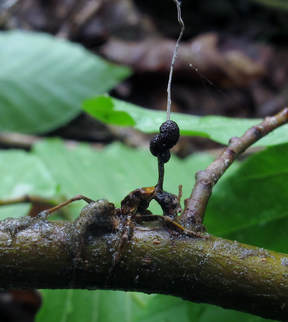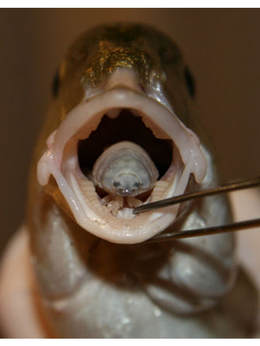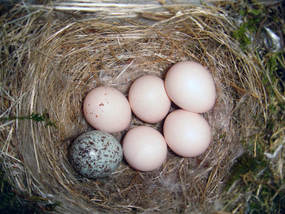|
10/23/2018 0 Comments Animal tricks for treats!
By Darren Incorvaia
October (or as I like to call it, Spookytime) is without a doubt the greatest month of the year. Ghosts, ghouls, and gremlins prowl around every corner; dentists put down payments on that new boat they’ve been eyeing; everything is right with the world. The truly great thing about spookiness, however, is that it transcends the month of October. Spooky stuff can happen at any time of year, and can even find a home in a subject that many people (incorrectly) assume to be dull and dry—science. That’s right, science can be spooky, and if you don’t believe me I’ve got the receipts to prove it. Humans may have to settle for trick OR treat, but other animals are more than capable of having both… Let’s start with a classic: zombies are real. Zombie ants, that is. Ants infected with the fungus Ophiocordyceps unilateralis display an odd—and very specific—behavioral pattern. The ant climbs up the stem of a plant and onto a leaf, clamps down on it with its mandibles, and dies. Yeah, the ant just sits there and dies. The fungus can then produce fruiting bodies (the reproductive bits) that grow out of the ant’s head and release their horrid spawn out into the tropical breeze. In this way, the fungus tricks the ant into giving it a very sweet treat indeed—reproduction! These fungal spores can then find new ants to zombify, continuing the cycle that will undoubtedly one day lead to a zombie ant uprising. Come to think of it, a remake of Night of the Living Dead where the zombies are ants instead of humans could be exactly what the world needs… Another great animal trick will be a big hit with people who like body horror: the tongue-eating louse that infects fish. This little parasite, as you can probably guess, eats the tongue of its victim before attaching itself to the muscles left behind. The louse can then spend the rest of its life masquerading as a tongue, getting plenty of food for itself every time the fish eats. Since the louse is attached to the fish’s muscles, it actually functions a lot like a normal tongue…except for the whole being-an-organ-eating-parasite part. Some fish have even been found with more than one of these parasites in their mouths, which apparently doesn’t do anything that bad other than make the fish underweight. Yeah, suddenly I’m thinking The Incredible Mr. Limpet isn’t as lighthearted as it seems… Trickery can be very risky, as the cost of punishment can be high if you’re found out. This means the potential benefits must be even higher in order for an animal to take the risk. Raising a child is one of the most time-consuming and energetically-draining things an animal can undertake (just ask any parent you know); therefore, any chance to pawn off the effort of raising offspring on someone else would be highly beneficial. Enter the cuckoos. There are cuckoos, also known as brood parasites, in several different animal groups: most famously in birds, but also most personal to me in bumblebees. These brood parasites essentially rely on unwitting members of another to raise their offspring for them. For example, cowbirds lay their eggs in the nests of other birds, who raise the baby cowbirds as if they were their own offspring. Cuckoo bumblebee queens take over entire nests of another species, forcibly removing or killing the original queen and forcing the workers to raise their offspring instead. I can’t imagine anything more terrifying than putting in all the work of raising a child with none of the rewards! These are just a few of the many ways that animals can trick one another to gain some sweet treats—deception and manipulation aren’t unique to humans after all! The important thing to remember is that all of these strategies evolved because they provide some fitness benefit to the trickster; that is, they help the animal survive and reproduce. This is the ultimate lesson of behavioral ecology: if you see an animal doing some weird or downright freaky thing, chances are that behavior exists because it helps the animal survive and reproduce. I hope you keep our spooky animal friends in your thoughts this Halloween! 
About the Author
Darren is a PhD student at Michigan State University studying the modulation of foraging behavior in bumblebees. Since 2015 he has written a blog, The Kingdom Has Come, focusing on many aspects of science (with an emphasis on animals) in a humorous light. In his spare time, Darren enjoys hiking, running, reading, and googling pictures of animals. Comments? Leave them below!
0 Comments
Your comment will be posted after it is approved.
Leave a Reply. |
LIFESTYLE BLOGRead our lifestyle advice, written exclusively for pre-professional women in science and engineering. From advice about fashion, work and family balance, self, wellness, and money, we've got you covered! |
The Scientista Foundation, Inc. All Rights Reserved © 2011-2021 | Based in NY | [email protected]
The Network for Pre-Professional Women in Science and Engineering
The Scientista Foundation is a registered 501(c)(3) -- Donate!
The Network for Pre-Professional Women in Science and Engineering
The Scientista Foundation is a registered 501(c)(3) -- Donate!




